 You know one of our favorite things about Jewish holidays? Most of them are an awesome excuse to get together with your HMI fam and eat delicious (albeit specific) foods!
You know one of our favorite things about Jewish holidays? Most of them are an awesome excuse to get together with your HMI fam and eat delicious (albeit specific) foods!
This time of year, we get to celebrate Tu B’Shevat, which you may know as the New Year or Birthday of the Trees. What you might not know is that there’s a fun tradition to host a low-key but festive meal, sometimes called a seder, featuring wine and a few fruits and grains known as the Seven Species (wheat, barley, grapes, figs, pomegranates, olives, and dates).
This Tu B’Shevat, we invite you to get your HMI crew together and try out some new recipes using the Seven Species! Do it potluck style where you each bring something using one of the species or get creative and make your own “Tu B’Shevat-cuterie Board!” (truly a millennial’s dream). Click here for some recipe ideas to get you started.
And be sure to apply for an HMI Alumni Micro Grant to help offset the cost of your gathering! We’ll reimburse you $10 per alum who attends your gathering. Click here for more info and to apply.
About the Holiday
 What is Tu B’Shevat? Tu B’Shevat, also known as the Birthday or New Year of the Trees, is a time to celebrate nature, renewal, and the earth’s abundance. People often mark the occasion by planting trees and enjoying certain fruits and grains that symbolize the richness of the land of Israel. These are known as the Seven Species, and they are listed in the Torah where Israel is described as “a land filled with wheat and barley, of grapes, figs, and pomegranates, a land of olive trees and [date] honey” (Deuteronomy 8:8). See below for more info and recipe ideas!
What is Tu B’Shevat? Tu B’Shevat, also known as the Birthday or New Year of the Trees, is a time to celebrate nature, renewal, and the earth’s abundance. People often mark the occasion by planting trees and enjoying certain fruits and grains that symbolize the richness of the land of Israel. These are known as the Seven Species, and they are listed in the Torah where Israel is described as “a land filled with wheat and barley, of grapes, figs, and pomegranates, a land of olive trees and [date] honey” (Deuteronomy 8:8). See below for more info and recipe ideas!
When do we celebrate? This year, Tu B’Shevat (literally meaning “the 15th of the Hebrew month of Shevat”) begins on the evening of Wednesday, February 12, through Thursday, February 13, but you can celebrate anytime in February! Tu B’Shevat usually happens in February since, by then, most of the year’s rain has already fallen in Israel, leaving the soil healthy and ready for planting new trees.
Ways to Celebrate
- Tu B’Shevat Seder: Explore how to bring nature, sweetness, and tradition to your table in an approachable (and delicious!) way.
- Activities for Kids from 18Doors: Teach your little ones about Tu B’Shevat through caring for the environment and connecting to nature.
- Judaism and Climate Change: Learn more about the connection between Judaism, the environment, and climate change and what you can do to get involved.
The Seven Species
Find inspiration and recipe ideas to bring the Seven Species into your Tu B’Shevat celebration! And don’t forget to apply for an HMI Alumni Micro Grant – we want to make hosting a Tu B’Shevat meal as easy as pomegranate pie.

Wheat – חִטָּה (Chitah)
The ancient rabbis taught “Where there is no wheat, there will be no Torah. Where there is no Torah, there will be no wheat”.
Fun Fact: Wheat is one of the most essential grains in the world and a staple in breadmaking in almost every culture. In ancient Israel, wheat was a symbol of prosperity and sustenance.
Recipe Idea: Olive Rosemary Vegan Challah – Check out this recipe by Micah Siva, a registered dietician, cookbook author, and HMI San Francisco alum, that packs a punch with not one but two of the Seven Species!
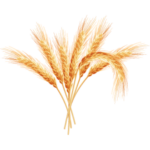
Barley – שְׂעֹרָה (Se’orah)
The barley harvest is the scene for the story of Ruth, the first person to choose to be Jewish in the Bible.
Fun Fact: Barley is one of the earliest cultivated crops in human history. It has been used for food, drink, and even as a measure of wealth!
Recipe Idea: Toasted Barley Pilaf with Mushrooms and Dill – Jewish cookbook author Susan Spungen always looked forward to Sunday dinners at her grandmother’s house, where this delicious pilaf was a standout dish.

Grape – גֶפֶן (Gefen)
After the famous flood, when Noah disembarked from his ark one of the first things he did was plant a vineyard. Some think that Noah brought grape vines into the ark in order to bring joy back to the world!
Fun Fact: Grapes were highly prized in ancient Israel and were used not only for wine but also for fresh eating, drying into raisins, and as offerings in the ancient Temple in Jerusalem.
Recipe Idea: Shrab – Libyan Golden Raisin “Wine” – Looking for a fun drink option to serve at your Tu B’Shevat meal? Jennifer Abadi, a sephardic and Judeo-Arabic chef, cookbook author, and friend of HMI shares this recipe for Shrab, a Libyan Golden Raisin “Wine” that combines raisins with sugar and water to create a sweet non-alcoholic treat!
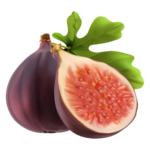
Fig – תְּאֵנָה (T’eenah)
Jewish tradition compares the study of Torah to a fig tree, offering new insights and meanings each time we study its meaning. Since fig trees don’t ripen all at once, we can always find a ripe, delicious fig to enjoy – so too with Torah study and its many unfolding meanings!
Fun Fact: Figs are one of the oldest cultivated fruits in the world. They are even mentioned in the Bible 16 times along with vines as Israel’s most important fruit!
Recipe Idea: Everything Cookies – HMI alum Micah Siva’s recipe for these delicious “Tu B’Shevat worthy cookies” are a multitasking marvel, packed with four(!) of the Seven Species.
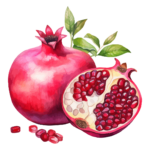
Pomegranate – רִמּוֹן (Rimon)
The ancient rabbis believed that if you see a pomegranate in your dreams, your livelihood will flourish like the many seeds of a pomegranate. Sweet dreams!
Fun Fact: Pomegranates symbolize righteousness, as they are said to contain an average of 613 seeds, corresponding to the 613 mitzvot (commandments) in the Torah.
Recipe Idea: Winter Green Hazelnut and Pomegranate Salad with Honey Prune Sauce – This bright, vibrant salad recipe from Rose Wilde, a cookbook author, recipe developer, and HMI Los Angeles alum, is sure to bring a pop of color to your Tu B’Shevat meal.
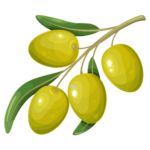
Olive – זֵית (Zayit)
“But the olive tree is not to be uprooted, for it is the source of nourishment” (Deuteronomy 8:8).
Fun Fact: Olive trees can live for thousands of years. There are surviving olive trees in Israel purported to be over 3,000 years old! They’re also considered a symbol of peace, resilience, and continuity.
Recipe Idea: Olive Oil Lemon Crinkle Cookies – Olive oil is a great addition to many desserts! Check out this recipe from Jake Cohen, chef, cookbook author, self-proclaimed Nice Jewish Boy, and friend of HMI.
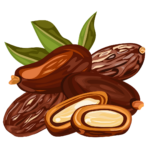
Date – תָּמָר (Tamar)
The biblical judge Deborah the Prophetess sat under a date palm tree, where she rendered her judgements to the Israelites with fairness and sweetness.
Fun Fact: Dates are a traditional symbol of sweetness and were often used to sweeten foods in the ancient world. The date palm is also often referred to as the “Tree of Life.”
Recipe Idea: Date Tahini Cottage Cheese Ice Cream – Looking for a sweet way to end your Tu B’Shevat meal? Look no further than this decadent treat by Micah Siva, which combines the natural sweetness of dates with a sweet tang from cottage cheese and natural nuttiness from tahini, or sesame paste.
Hungry for More?
Check out more ways to celebrate or honor Tu B’Shevat below.
- Acts of Service: Tu B’Shevat also serves as a meaningful opportunity for tikkun olam (repairing the world). Take some time to learn what we can do to help those experiencing food insecurity. The innovative virtual Hunger Museum by MAZON: A Jewish Response to Hunger works to end hunger for people of all faiths and backgrounds.
- Sustainability in Israel: Israel is making major strides in worldwide sustainability. Did you know that Israel is ranked 24th in the Global Sustainability Index? For comparison, America is ranked in 197th place. Learn more here.
- Host a Discussion: As part of your Tu B’Shevat celebration, consider incorporating this short discussion guide on women fighting for sustainability through the ages from Repair the World, an organization that mobilizes Jews and their communities to take action to pursue a just world.




